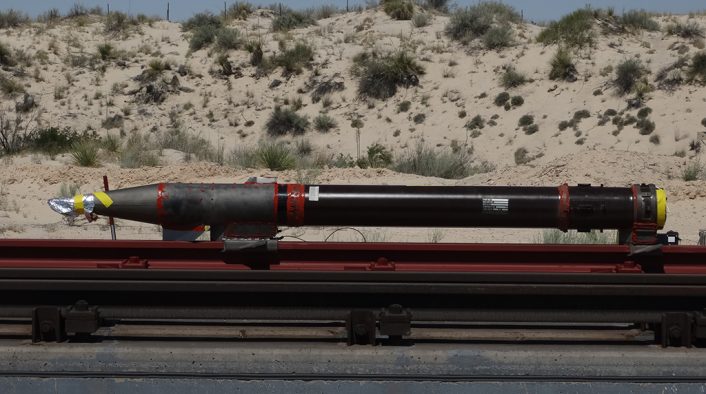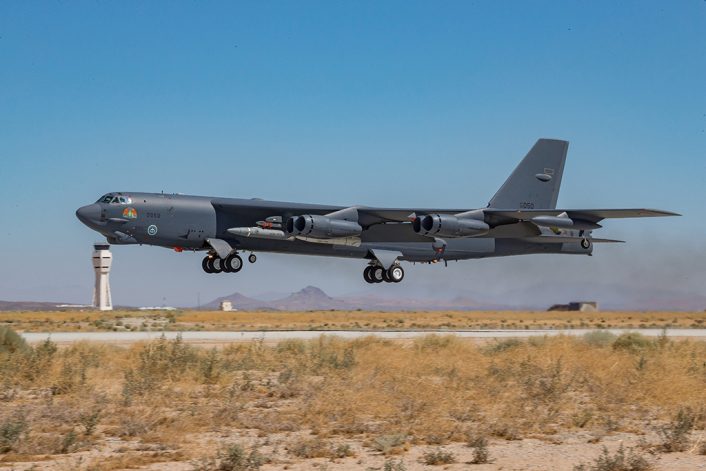The 846th Test Squadron at Holloman Air Force Base, New Mexico, is working to get its hypersonic sled testing program ready for the future Air-Launched Rapid Response Weapon (ARRW).
Located at Holloman Air Force Base, New Mexico, and operated by the 846th Test Squadron, Holloman High Speed Test Track (HHSTT), 51,000 feet (about 10 miles) is one of the world’s longest tracks. It uses a special sled that can be launched at speeds in excess of 9,000 feet per second, that is around Mach 8.6 calculating for altitude!
The mission of the HHSTT is “to provide a cost-effective, realistic, dynamic test environment for the entire acquisition community, including the DoD, and contractors.” Various tests are carried out at the track, including simulated ejections using ATDs (Anthropomorphic Test Devices), and weapons.
In the near future, 846th TS, belonging to the 704th Test Group of the Arnold Engineering Development Complex, will support testing on hypersonic weapons conducted as part of the Hypersonic Readiness (HSR), an in-house project to prepare the unit to carry out, among the others, the Air-Launched Rapid Response Weapon (ARRW) testing. Preparation for this program has started around 4 years ago and preparatory rocket sled tests have began last year at the HHSTT.
The HSR program currently consists of multiple dynamic sled test velocities, sled designs, environments and different braking media, says an official USAF press release.
“Due to current DOD priorities, it is expected that the frequency and complexity of hypersonic testing will increase over the next 10 years at HHSTT,” said Capability Development Lead Lee Powell.
Interestingly, the testing in 2021 will begin with the HyTIP (a 350M USD test infrastructure enhancement program) is planned for 2021, starting with weather effects testing, such as simulated rain encounter. Such testing in support of ARRW is expected to get underway in 2022.
With this task in agenda, the 846th TS had to revive, develop and rehearse hypersonic monorail sled test capabilities.

According to the U.S. Air Force, the HSR program is primarily focused on the hypersonic 9-inch monorail sled test capability and includes the revival of old, as well as the development of new, high-speed braking capabilities. Indeed, the old hypersonic sled braking techniques have been retired and the current ones do not allow recovery of the monorail sleds at the speeds required by the test.
That’s why something else had to be developed:
Before the HyTIP missions slated for next year and the subsequent ARRW missions are carried out, alternative high-speed braking methods and workforce training must be developed and demonstrated. The HSR effort mainly consists of the development of rail-top braking methods to ensure the sleds launched during testing can be recovered on the rail for post-test analysis.
Four tests have been conducted at the HHSTT as part of the HSR program thus far, the first occurring on June 26, 2019, and the most recent on Aug. 6, 2020. The tests have called for the acceleration of a monorail sled to the supersonic or hypersonic regime. The sleds then coast from peak to speeds ranging from 2,299 feet per second to 2,900 feet per second before entering braking. A new braking wedge design was developed and used on the sleds to interact with rail-top water bag braking and induce a momentum exchange to slow the sled during the testing.
In addition to studying braking performance, the fourth and most recent test called for the sled to be exposed to a 400-foot section of the newly-upgraded 6,000-foot HHSTT “rainfield,” a sprinkler head system designed to simulate natural rain.
“The basic concept was to demonstrate exposure of a developmental material to a ‘rain environment’ in order to test the effects of water droplets hitting a test article at hypersonic velocities; think about the understanding of whether a missile will survive being launched through a rain cloud,” said Bryan Sinkovec, Capability Development Program manager. “The HHSTT rainfield was recently upgraded with a state-of-the-art fiber optic control and data collection system in time to support the 2021 HyTIP missions.”
After exposure to the rainfield, the sled was projected to enter braking at 2,900 feet per second, but it entered much faster than planned.
The three prior tests were considered successful in determining the effectiveness of the new sled design. Each test resulted in safely-recovered sleds from the rail. The fourth test was considered a partial success because the sled departed the rail prematurely and was not recovered. However, some sled performance data was acquired.
Hypersonic Weapons
Thanks to their promised capability to effectively penetrate and control contested battlespace (Anti-Access/Area Denial Zone), overcoming challenges of time, distance, and enemy defenses, hypersonic weapons are attracting a lot of interest.
As explained by Stefano D’Urso in the article “The Status Of The U.S. Bomber Force Outlined By The vASC2020 Conference” published here at The Aviationist last month, the AGM-183 Air-launched Rapid Response Weapon (ARRW) hypersonic weapon could be a temporary measure until more advanced types come along.
The Air Force is currently looking to obtain a range of capabilities in hypersonics, with a range of weapons in different size categories. As a matter of fact, the service is looking both at a larger weapon with greater range to be carried by the bombers and a smaller one with less range or payload to be carried by fighter aircraft too. An example of this was seen in the F-15EX’s renderings which featured a hypersonic missile under the fuselage’s center pylon.
Another range of weapons will be available by using both boost-glide missiles, like the ARRW, and air-breathing missiles, like the new Expendable Hypersonic Air-Breathing Multi-Mission Demonstrator Program or “Mayhem” that is being developed, with the Air Force soliciting concepts for a preliminary design from Boeing, Lockheed Martin’s Skunkworks, and Raytheon, all with hypersonic and scramjet propulsion experience, and expecting a contract award in early 2021. Even of Mayhem is expected to be larger than ARRW, the missile is planned to be carried also by fighter aircraft.
The introduction in service of hypersonic missiles in the next years will increase the firepower of the B-52, the first scheduled to receive the new weapons, and the B-1. Gen. Ray stated that the AGM-183 ARRW should be integrated on the B-1 as soon as possible, as the bomber is expected to perform excellently in the standoff role with the weapons carried on the external pylons.
Meanwhile…
In August 2020, the U.S. Air Force has carried out the final captive-carry test of the AGM-183A Air-launched Rapid Response Weapon under a wing of a B-52 Stratofortress off the Southern California.

The flight resulted in the successful transmission of telemetry and GPS data from the AGM-183A IMV-2 (Instrumented Measurement Vehicle) to Point Mugu Sea Range ground stations. The test verified system integration with the B-52 launch platform and telemetry while practicing concepts of operations that will be utilized during its first Booster Test Flight later this year.









